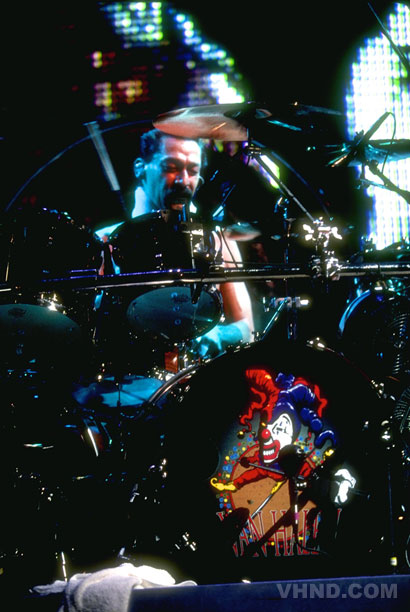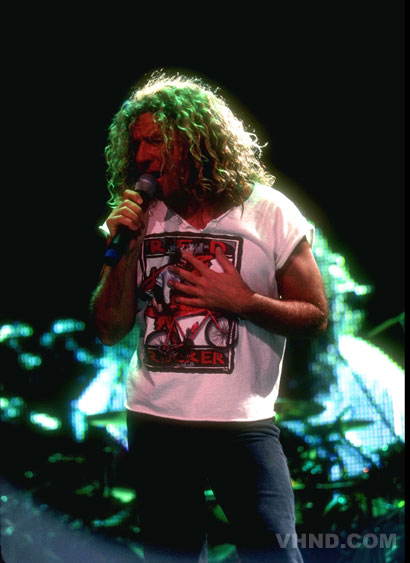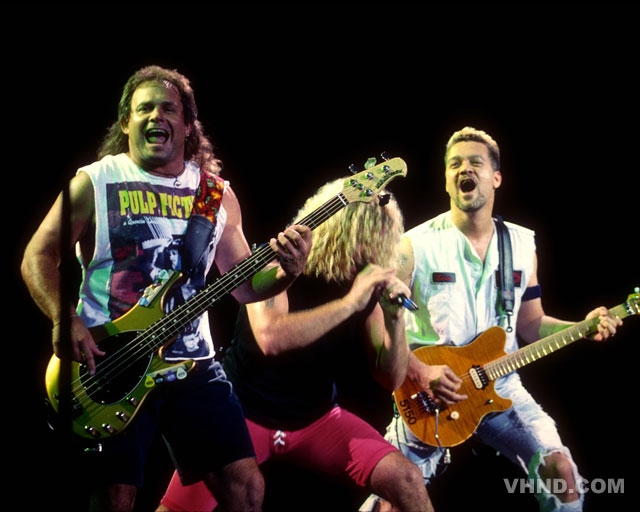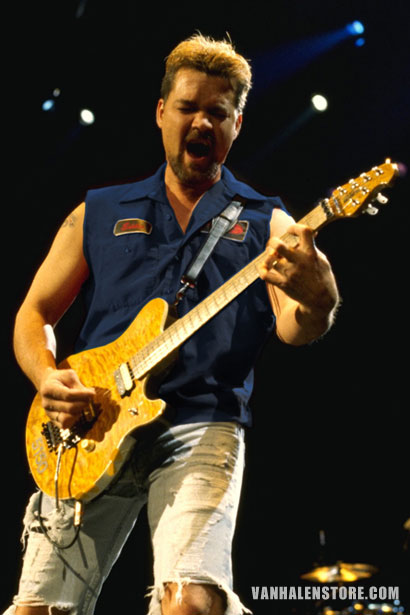On March 11th, 1995, Van Halen kicked off the Balance Tour!
Van Halen’s 1995 tour—in support of the Balance album—was dubbed the “Ambulance Tour” by Eddie because of the hip and neck injuries sustained by himself and brother Alex. Despite those health concerns, this was another massive year for the band. Like their three previous albums, Balance debuted at #1, and the tour lasted 131 shows and grossed well over 30 million dollars. This would be the group’s last tour with Sammy Hagar on vocals until 2004, when he briefly rejoined the band for the 2004 reunion tour and the Best of Both World’s greatest hits CD.

Jumbotron
The updated stage show was elaborate—and expensive. Bringing living room comfort to a country of couch potatoes, the band added a new element to their stage show on this tour: the Jumbotron. Initially Alex’s idea, this was the band’s first time touring with a video production. The Jumbotron was a giant screen, similar to a television set, located above Alex. This was only the second time the setup had been used in arenas. Barbara Streisand was the first to use it in this manner. A six-man video team using four operating cameras and three point-of-view (POV) cameras, two of which were located on Alex’s drum kit, filmed the band, the crowd, and more, projecting the images onto the giant screen. The MTV-banned “Amsterdam” video was also shown on the Jumbotron. One of the stranger video effects was a projection of Sammy Hagar’s face on a giant dollar bill during “Big Fat Money.” At the end of each show, the Balance album cover twins would appear, saying their goodbyes to the audience.

The band also hired a high-tech Autopilot system so that lights would automatically follow the musicians using infrared and ultrasonic cues. They were the second band, after ZZ Top, to adopt the system–a quantum leap ahead of the lighting stomp pedals Michael Anthony had brought with him from Snake when he joined Van Halen twenty years earlier.
A total of seven stage cameras brought the sweaty details of every performance to the back rows, just like at a sporting event. With short hair, work shirts with name patches, and ripped blue jeans, Van Halen now looked like a bunch of guys who had just finished hanging drywall in the basement and decided to jam a few Top 40 tunes.
Opening Bands
Van Halen had various openers for the U.S. shows. The bands were: Skid Row, Collective Soul, Slash’s Snakepit, Our Lady Peace, and Brother Cane.
Album Promo Tour
During the short European album promotional tour in January, the band played a supposedly secret club show [pro video linked here] for the Dutch 5150 fan club in Holland. Word leaked, and three thousand fans waited in the cold and snow for hours hoping to catch a glimpse of Holland’s greatest rock export, sympathetically singing “Happy Birthday” to Eddie on his fortieth birthday. The gig was broadcast live over national radio, renewing interest in the band due to the warm intensity of the performance. The band also performed a club show in Milan, Italy [pro video linked here].
The Tour: First and Second North American Legs
The tour began March 11th with a sickly spring cough, as flu-stricken Sammy Hagar struggled to make dates. Eddie’s knees wobbled the first night in Pensacola, Florida, as he looked out over a capacity crowd of over nine thousand fans and prepared to play sober for virtually the first time in his career. He found that he liked being aware of the audience and enjoyed the process of coming out of his shell.
Sammy’s ailing throat forced the band to cancel a night in Orlando, Florida, and then three shows in California in early April. Some nights his vocal outages became a boon for fans, like when the band broke from its preordained routine for a ten-minute jam on the longed-for “Ain’t Talkin’ ‘Bout Love.” Some nights, Eddie would pop into the intros for old unheard ghosts like “Mean Street,” “Romeo Delight,” and even “Runnin’ with the Devil.” He seemed to be chafing at the bit to play original Van Halen classics despite Sammy’s reluctance. Fans definitely wanted to hear them—those first six albums continued to garner multiplatinum sales—and crowds screamed while Eddie teased them.
 The still-inscrutable Alex appeared to be taking bizarre drummer behavior to new heights, performing with a Freddie Mercury walrus mustache and a neck brace. The neck support was not just a weird wardrobe choice, however–Alex had ruptured three vertebrae while hoisting his son onto his shoulders. Eddie mentioned a childhood treehouse accident and a teenage spill, earlier injuries whose effects had accumulated with time.
The still-inscrutable Alex appeared to be taking bizarre drummer behavior to new heights, performing with a Freddie Mercury walrus mustache and a neck brace. The neck support was not just a weird wardrobe choice, however–Alex had ruptured three vertebrae while hoisting his son onto his shoulders. Eddie mentioned a childhood treehouse accident and a teenage spill, earlier injuries whose effects had accumulated with time.
Eddie continued leaping high, but his moves were increasingly curtailed by a throbbing pain in his hip. Thinking he had taken a bad swivel on the golf course, he underwent CT scans and MRIs. He was diagnosed with an avascular necrosis—a loss of blood supply to his joint that had made the ball joint of his hip collapse. Doctors recommended surgery immediately. Instead, he bought a cane and continued with the tour. “I’m hobbling, yeah,” Eddie said. “It’s from years of hopping around onstage and drinking, not feeling what I’m doing to myself. I’m almost seven months sober now, so the pain is a lot worse.”
Then on April 7, 1995, the Oakland show was canceled after Eddie was arrested at Burbank Airport for boarding a plane with a loaded .25 caliber pistol. “First commercial flight after an eternity of charters,” he said with a shrug, explaining that the gun had become a constant companion after years of stalkers and psychodrama. Eddie went to court, paid a $1,000 fine and was handed a year’s probation.
As the tour continued, Valerie remained a supportive presence, popping in with four-year-old Wolfgang in tow to announce the latest findings she’d dug up as a mole digging through Van Halen’s various AOL chat rooms—one of the first places for Van Halen chatter on the internet. One day, while the family was driving together, Van Halen’s “Hot for Teacher” came on the radio. “I said `Wolfie, that’s Daddy,'” Eddie laughingly told the Albany Times-Union. “He said, `It sounds like Daddy playing guitar, but who’s that singing? That doesn’t sound like Sammy.'”
Alex shaved his impressive facial hair, but his drum solo still included a routine of him playing alongside a prerecorded video of himself on the giant screens–still wearing what looked like a paste-on Groucho moustache. That quirk in the otherwise seamless shows gave a glimpse into the perverse humor of Alex’s world. He displayed his superiority wordlessly, banging out hailstorms of Latin-style percussion on the world’s loudest drums.
A $10,000 big-screen nature video for “Eagles Fly”—a ballad from Hagar’s 1987 I Never Said Goodbye album—became a nightly set piece. Sammy started slowly playing guitar by himself, and then the band joined him to create the big finish. “You throw another guitar player out there and Eddie’s not used to that,” Sammy told Guitar. “When I start playing I mean it, and he feels that. I say, `Come on, motherfucker, you can kick my ass but you’re going to have to kick it good.’ It makes him play, and I like that aspect.”
Cutting back on his ritual pre-show bourbon, Michael Anthony began incorporating Bach fingerstepping phrases into his lengthy bass solo. He now had a Tabasco bass in his arsenal, but like the Jack Daniel’s instrument, the copyright holders got wind and ruined the innocent spirit of the tribute. Tabasco asked him for the bass to hang near their headquarters at the Hard Rock Cafe in New Orleans. They paid for Mike to build a new one, but to his chagrin the graphics weren’t as inspired the second time around. He remained the most easygoing member of the band, always flashing his 1977 smile. “I calm down once I’m onstage,” Mike told Guitar. “Audiences are different. It’s almost like meeting somebody famous for the first time–you start out nervous and then calm down.”
A new addition, former Night Ranger, Montrose, and Sammy Hagar band keyboardist Alan Fitzgerald, lurked in a dark tent off to the side of the stage, triggering prerecorded samples of special effects like strings, gongs, and bells. He also cued the keyboard lines for “Jump” and “Right Now” so Edward would be free to play guitar.
 Though still a formidable live act, the band seemed listless. Sammy’s vocals often floated to the background rather than penetrating—although the loyal crowds sang along most of the words anyway. Introducing “Not Enough” in Toronto, he stood on a soapbox. “This song deals with a relationship situation. It’s about true unconditional love, which is the only time you ever feel love. Us guys are kinda dumb sometimes, we always want our women to prove to us how much they love us so we can open up and show our love to them. You can only feel love when you give it, you can’t feel love when you take it.”
Though still a formidable live act, the band seemed listless. Sammy’s vocals often floated to the background rather than penetrating—although the loyal crowds sang along most of the words anyway. Introducing “Not Enough” in Toronto, he stood on a soapbox. “This song deals with a relationship situation. It’s about true unconditional love, which is the only time you ever feel love. Us guys are kinda dumb sometimes, we always want our women to prove to us how much they love us so we can open up and show our love to them. You can only feel love when you give it, you can’t feel love when you take it.”
Sammy couldn’t be faulted for sharing some personal insight, but Van Halen’s audience hardly expected the world’s foremost sires of hard cock arena rock to lecture them about sensitivity. It seemed a little too late for Van Halen—especially after the F.U.C.K. album had strapped its male sexuality to the front of a locomotive and rammed it home.
European Leg
Believe it or not, this tour featured the band opening for Bon Jovi on the European leg of their tour. The reasoning behind this move was that the band needed to broaden their European fan base. What better way to do it then play alongside Bon Jovi, who are downright huge in Europe? As opposed to the years of untouchable success they’d experienced in the United States, Van Halen were becoming a nonentity across the Atlantic, performing fewer than twenty dates in the past ten years. When they appeared with Roth on German and Italian television during their early years, the gaudy high kicks and smiling faces had impressed the dour Continental rock audiences, but in recent years Van Halen suffered for its lack of loyalty to the European rock community.
During the European trek with Bon Jovi, Alex was shocked when a fan asked after a concert if they had any other records besides Balance. “The tour is a rock and roll band and a bunch of posers together,” he told a German paper. “We indeed play the same venues Bon Jovi plays, but we simply wanted to play in front of as many people as possible. The sad thing about it is that he, Bon Jovi, tries to get some credibility out of it.”

Hoping to make their return to Europe a low-stress adventure, Van Halen only made problems for themselves. “That was pretty much a mess,” Mike later agreed. “We came away with a big following, but trying to handle Mr. Bon Jovi became a bit stressful after a while. He even complained to our manager that we wouldn’t come out after our set and watch his band play.”
The May 1995 open-air appearance with Bon Jovi in Eddie’s birthplace of Nijmegen was plagued by a Sammy Hagar wardrobe malfunction. Unfortunately, Sammy wore of an Ajax soccer jersey—representing the effete rival team from Amsterdam. Sammy’s gesture was about as welcome as a Chicago Bears jersey would be in Green Bay, Wisconsin.
A plethora of other bands also shared the bill on Van Halen’s European dates, including Thunder, Ugly Kid Joe, Crown of Thorns, Slash’s Snakepit, The Pretenders, Otto, Little Steven, Bad Moon Rising, and others.
Third and Fourth North American Legs
Back in the States, the remaining dates had their share of highlights. In Minneapolis, a coterie of bald, chanting monks wearing red gowns, hailing from Gyuto Tantric University, opened the show with the hypnotic drones leading to “The Seventh Seal.” The Toronto show was recorded for a pay-per-view performance. To reward their crew for putting up with movie cameras, lights, and the extra labor, the band rented a boat and took their hardworking road dogs for a cruise around Lake Ontario.
In Denver, the crew began setting up as usual for an outdoor show. The forecast called for snow, in September—and for once, the weatherman was correct. The band performed through a pounding snowstorm, trading snowballs with the audience. Hagar slipped and fell on his ass. By the time they were done, nine inches of white stuff covered the city. Then on October 6, Van Halen were inducted into Hollywood’s Rock Walk, for their “significant contribution to the evolution of Rock and Roll as a universal art form.”
Yet in the view of many observers, management was milking Van Halen, forcing them to continue to work when they needed time apart and rest—especially Alex who was injured and wearing a neckbrace.
The band finished its tour with two dates in Hawaii in early November 1995. Hagar married his girlfriend, model Kari Karte, on November 29.

USA Harvest
The band continued collecting food for USA Harvest, asking for fans to bring canned food to concerts. Donations far surpassed the contributions from 1993, totaling over 360,000 cans. The Presidential Points of Light Foundation had celebrated the charity in 1994. Now for their ongoing efforts Van Halen were invited to the White House by President Clinton. Against all advice, they declined. “I don’t dig the guy,” Hagar told [Van Halen magazine] The Inside. “I didn’t vote for the guy and I certainly wouldn’t vote for him again. The only thing I’ll say good about Clinton is that I like what he’s doing to the cigarette companies. No one’s ever fought those people before. “
Michael Anthony
Mike added a nod to J.S. Bach’s “Toccata and Fugue” in D minor (recognized by many as the macabre organ piece from the Phantom of the Opera) to his bass solo on this tour. His bass setup included five Music Man 4-string basses; two in metallic gold, two transparent red, and one sunburst. Each was outfitted with a 2TEK bridge designed by Anthony and Linn Ellsworth and were otherwise stock with the exception of an added thumb rest and the removal of the three-position pickup selector switches (the pickups were hardwired for series-only operation). All the basses were strung with Ernie Ball Hybrid Slinky strings, gauged .045 to .105. Rig-wise, Michael used three racks of gear. The first housed Samson UR-4 and UR-5D wireless receivers. His main rack consisted of two Ampeg SVT-Pro preamps, a Bradshaw switching system, a Custom Audio Electronis 3+ Tube Preamp (for the bass solo), two Roland SDE-3000 digital delays (set to 579 and 279 milliseconds), two Boss SE-70 multi-effects units (for distorted flange), and an Ampeg SVT-3000 power amp (used as a spare). The third rack housed three Ampeg SVT-300 300-watt mono tube amps; two power a pair of Ampeg SVT810Es each, and the third was a spare. He also kept some standby units from previous tours including an ADA flanger, an Electro-Harmonix Bass Micro-Synth, a Colorsound fuzz, and a Roland DC-30 chorus/echo unit.
Prior to the start of the tour, Mike teamed up with Peavey and tried out a CyberBass, a bass-to-MIDI controller that connects to a rackmount sound module. The CyberBass was a precursor to a similar concoction known as a MidiBass. He considered using it during his bass solo, but didn’t for unknown reasons.

Alex Van Halen
Alex drank a homemade garlic and carrot drink each night before taking the stage, that had a tendency to leave a rather garlicky-smell all around him and his drum kit. This practice made Alex the butt of many jokes. His solo featured a segment where he played against a recording of himself, showering the crowd with a rather Latinesque treat.
Edward Van Halen
Ed brought “Franky” out on the tour during the first leg, but ended up not using it for unknown reasons. Eddie also played one of his Ernie Ball Music Man guitars from time to time, which had black electrical tape covering the Music Man logo, probably due to the fact that he was now endorsing his new Peavey Wolfgang line. Early in the tour, Eddie began to experience intense pain in his hip, which was later diagnosed as Avascular Necrosis. It was common to see him standing relatively still for most of these shows, even sitting on a red, white and blacked striped stool on more than one occasion. By tour’s end however, he was much more active, either getting used to the pain or doing a hell of a job masking it. His solo featured several Roth-era song teasers including the verse section to “Mean Street” and the intro to “Runnin’ with the Devil”, as well as a nod to the 5-note communication sequence from the movie Close Encounters of the Third Kind. The final leg of the tour featured the guitarist following in Alex’s footsteps: he also played against a recording of himself.
Big Fat Money
The band grossed a staggering $32.7 million in support of Balance. Other top grossing acts for the year included the Eagles with $56.6 million, the Grateful Dead, R.E.M. and Page & Plant.
 Typical Set List:
Typical Set List:
- Right Now [or Seventh Seal]
- Big Fat Money
- Why Can’t This Be Love
- Top of the World [sometimes]
- Runaround [sometimes]
- Not Enough
- Amsterdam
- Bass solo
- The Seventh Seal
-
- Aftershock
- Mine All Mine
- Drum solo
- Can’t Stop Lovin’ You
-
- Feelin’
- Eagles Fly
- Ain’t Talkin’ ‘Bout Love
- Guitar solo
- You Really Got Me
- Jump
- One Way To Rock
- Dreams
- Poundcake [sometimes]
- Don’t Tell Me [sometimes]
- Panama
This Balance tour page was written by VHND, contributing writer CJ Chilvers and Ian Christe, author of Everybody Wants Some: The Van Halen Saga. Photos from VHND’s archives.